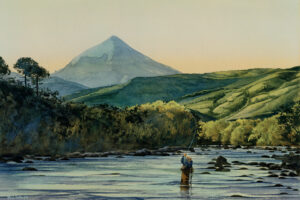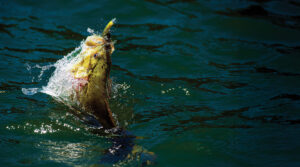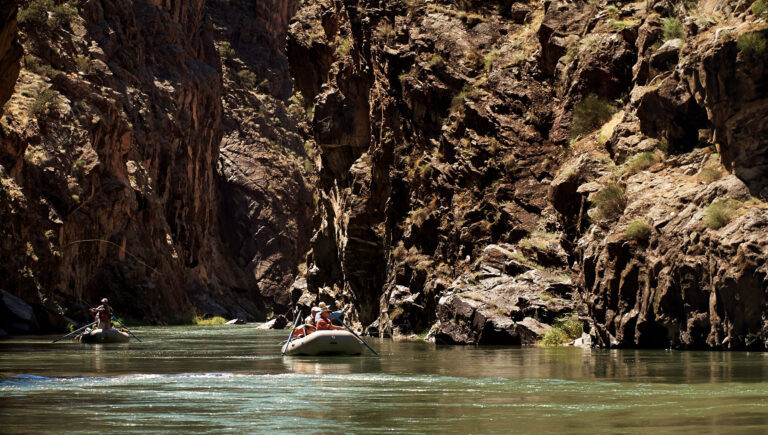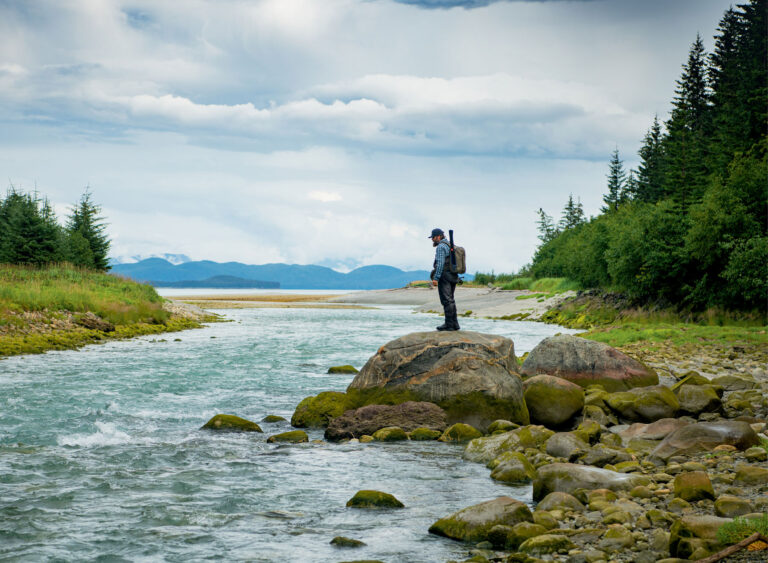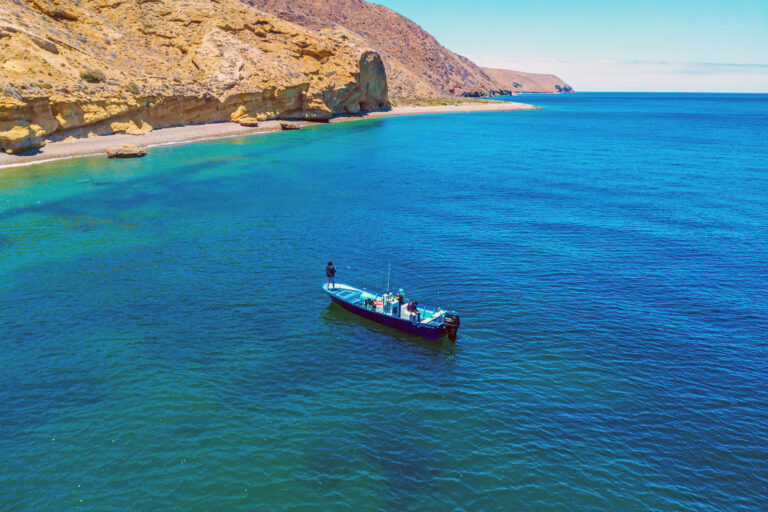There’s a passion for adventure within many of us, a force that drives some to push the boundaries and explore places far off the beaten path. I guide wilderness fly-fishing trips in Alaska for a living, yet I still yearn to discover special places where few anglers (if any) have fished before.
When I visited the 49th state for the first time eight years ago, it unlocked in me a compulsion to seek out pristine rivers. A person could spend a lifetime exploring Alaska and barely scratch the surface. Every couple of years, my business partner, fellow adventure junkie and longtime friend Pete Jaacks and I plan a trip into the unknown in hopes of finding untouched Alaska rivers with extraordinary fishing.
 Releasing a leopard rainbow trout, a ritual the men repeated many times.
Releasing a leopard rainbow trout, a ritual the men repeated many times. Finding these waters requires research, planning and waiting for the right conditions, not to mention years of experience in the Alaskan wilderness. The landscapes we seek rival the dreamy computer backgrounds most people stare longingly at throughout their days. Few know of such places, and fewer still explore them. Keep looking. With a little luck and a lot of preparation, you just might find what you’re looking for.
After five years of planning, the stars aligned for a special trip. I’m not going to tell you where this little river is, except to say it’s in Alaska. I’ve always felt it was far more satisfying to find spots through your own sleuthing and homework than having someone essentially draw you a map. We traveled light and packed only the necessities. During our inbound floatplane flight, we gazed at hundreds of miles of tundra and snow-capped peaks. “The river could have no fish in it at all,” the pilot warned. True enough, but we were willing to bet otherwise. And not knowing is part of the adventure.
 Pete Jaacks takes in the tundra a few miles from the headwater lake that feeds “Trout Creek.”
Pete Jaacks takes in the tundra a few miles from the headwater lake that feeds “Trout Creek.”Our only possible landing zone was a mud puddle just big enough for a small Cessna in high-water conditions. We portaged a half-mile through a maze of hummocks, tall grasses, stagnant ponds and clouds of mosquitoes before reaching a clear river we came to call “Trout Creek.” It might sound demanding, but if it were easy to reach, others might be fishing here.
We took turns walking our small inflatable canoe down the shallow headwaters. We alternated positions, which we called batting “lead off” or hitting “cleanup,” to ensure we each had fair shots at working unspoiled water. My first four casts produced four Arctic grayling, which were far larger than average size. A few minutes later, an 18-inch rainbow ate my streamer and took off downstream. We figured it was a trophy, unaware of what was to come.
 The writer with a smolt-eating rainbow.
The writer with a smolt-eating rainbow. By the end of the first day, we had traveled less than four miles and caught dozens of fish, including rainbows that went more than 2 feet. Our biggest problem was making miles because the fishing was too good to move quickly. Every section held fish. We made camp late and sat by the fire in a mixture of silence and laughter, devouring freeze-dried meals. We passed a bottle of whiskey, and the sun kept us company late into the night. “I didn’t think anything could be better than our last expedition, to ‘Jungle Creek,’ ” Pete said [see Anglers Journal, Spring 2018]. But this one was off to a strong start.
The madness began as tributaries joined the river and we came out of the shallow headwaters and into deeper water. Unlike our previous springtime explorations, these fish were only interested in eating small salmon fry. The name of the game was throwing small streamers to big fish. Our instincts guided us to side channels where we sight-cast to big rainbows. We realized we would be here all summer if we didn’t cover some ground, so we hopped into the boat and kept moving.
 Jaacks collects firewood for the day’s camp.
Jaacks collects firewood for the day’s camp.The angler in the stern rowed while the one in the bow fished until he landed a rainbow bigger than 20 inches, which usually happened in minutes. Then we switched places. As we covered ground, we stumbled across dozens of large rainbows crashing smolt in ferocious explosions. These feeding frenzies were unlike anything I’ve seen with freshwater fish. They were far more reminiscent of saltwater species. Our flies hit the surface, and rainbows between 20 and 25 inches instantly engulfed them. We lost count as fish after fish made their way to the net.
When a feed petered out, we moved to the next pod of crashing fish. It got to the point where we would only stop if we saw fish blowing up. We paused above a seam with frothing white water below, and on three swings I put three 20-inch fish in my hand. We dubbed these fish “one-handers.” The trout acted like sea-run salmon. They were bigger, faster and fought harder than any rainbows we’d seen. It was impressive. The only explanation we could come up with was that they ate well year-round and spent time in salt or brackish water.
 Jaacks and “Linda” scout downriver.
Jaacks and “Linda” scout downriver. As we drifted downriver, territorial terns dive-bombed our canoe. A paddle held in the air was a marginally effective deterrent. With no sign of humans, this turned out to be the sanctuary of our dreams. Surrounded by natural splendor, we took every opportunity to hike towering bluffs and look out into the vast landscape while scouting downriver. Pete and I stood side by side on a bluff, taking in the view and communicating our appreciation for the river without a word spoken.
Aside from the headwaters, the river almost exclusively held rainbow trout. We saw only a handful of salmon, but I caught a bonus trophy while fishing a pod of blitzing rainbows. The hit was soft, but the fish was heavy and bulldogged into a deep hole, unlike the trout we’d been catching. When the fish came close, I saw the silver sheen and black-spotted back of a king salmon. Pete scooped the 25-inch Chinook into the net, and we marveled at it before returning the fish to its spawning mission.
 The young men landed their fish solo unless one was deemed “large.”
The young men landed their fish solo unless one was deemed “large.”On the evening of the summer solstice, we sat on the gravel next to the fire and pondered how much it would cost to bring someone to this river. Numbers with lots of zeros were thrown around, with endless contingencies. This was the best wild rainbow fishery we’d ever experienced, and we acknowledged that some waters could not be bought for any price; they need to remain sanctuaries, with zero pressure.
By our final full day on the river, the fishing had far exceeded our expectations. Fish from 23 to 26 inches were the norm, and each day impressed us more than the one before. I was on the bow, as Pete rowed us through a deep bend, when we flushed out a tall, ruby-red-striped rainbow in the mid-20-inch class. We pulled the boat on shore, and Pete trudged up the bank, a 6-weight in hand. I sat on the raft and watched Pete methodically swing his fly to the opposing bank until he called for a net man. I scampered upstream as the fish drew close, and we caught glimpse of a monster in the 30-inch class before it turned and spit the fly. “Sometimes it’s good not to catch the big one,” Pete said. “It leaves you something to come back for.” Indeed.
 A 14-foot inflatable canoe was the perfect vessel for transporting gear and exploring.
A 14-foot inflatable canoe was the perfect vessel for transporting gear and exploring. We let the bend rest while we sat on the riverbank, laughing and feeling privileged for the encounter. We decided we had to go up farther and work the bank again. I took the lead this time, swinging deep into the woody, undercut bank. After several swings, my line got heavy, and I strip-set hard. Feeling the weight of the fish, I called for backup. When it came into sight, I realized she was the girl of my dreams.
I maintained pressure, as my 7-weight bent to the cork, to keep her out of the wood. After a trying battle, Pete slid the 28-incher into the net just as the fly dropped out of her mouth. Her iridescence was unlike the golden fish of the upper river. “That’s a steelhead, bud,” Pete said. This was a phantom in these waters and, potently, a true steelhead. Dumbstruck, I returned to the raft to collect my thoughts as Pete fished the rest of the run.
 The rainbow that prompted the final stop on the river, a stretch that held the largest fish of the trip.
The rainbow that prompted the final stop on the river, a stretch that held the largest fish of the trip.If two fish of this caliber existed in this small section of river, could there be three? At the end of the run, on his final swing, Pete came tight. There it was, the ruby-striped fish that prompted our stop in the first place. The powerful alpha peeled off line and had Pete wishing he was fishing something heavier than a 6-weight. Pete is no stranger to playing big fish, and he skillfully worked it into netting range. Once the fish was in the bag, we gazed at its beauty: The rainbow was long, robust and colorful — perfect in every way. We released the fish, took a pull of whiskey and enjoyed the tall grasses bowing in the spring wind.
So deep was our satisfaction that we put down our rods and headed downriver to locate our final camp. We didn’t need to fish anymore. We spent our final night under the midnight sun and met our pilot in the morning at a designated pickup point. We’d found the fishery we were looking for; our planning and preparation paid off. Gazing over the tundra on the flight back, we dreamed of our next adventure. The fishing can’t always be as spectacular as it was on Trout Creek, but the Alaskan wilderness rarely disappoints.




